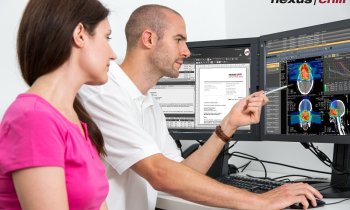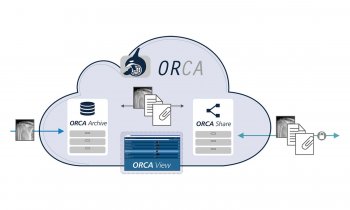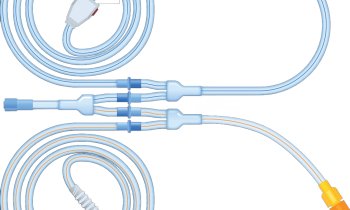Mobile radiology diagnoses
MORTIS is a new teleradiology system which utilises high-resolution laptops to receive images for diagnostic purposes.

Gregor Wedekind MD (right) offers radiological services to the local hospital and outpatients in Kempen, a city in the West Ruhr Area of Germany. Having searched for a mobile radiology system for some time, he has opted for a new teleradiology system called MORITS. This utilises high-resolution laptops to receive transmitted images obtained during a medical emergency, so that radiologists situated virtually anywhere can supply a diagnosis.
During a recent interview with our journal, Dr Wedekind presented a scenario to explain its use: ‘A private radiology practice works with a hospital that has no facilities for interface diagnostics. However, when the practice is closed for the night, or over weekends, no one is using its costly and very useful equipment, which amounts to about 75% of the time. To provide the hospital with emergency cover someone has to be at the practice to make a diagnosis. However, with only three available radiologists, this would boil down to 10 nights of cover for each radiologist per month - and more during holiday periods. Hence we had to find a solution and began to focus on teleradiology - available for quite some time over a fixed network. In this, data has been transferred from a CT scanner via a fixed network line to a PC installed at home - but again, the radiologist must be stationed at home. So, we looked for a solution that facilitates total mobility - and eventually we found it.
‘Major providers, whether film suppliers or firms specialising in medical technology, had no solution to match this concept. On the contrary, they even disputed that something like this could be developed. Anyhow, we have done it and it works. The licensing procedure, with the Health and Safety Office in North-Rhine Westphalia, was another story... but approval for its use was received after radiology experts examined the equipment and deemed it serviceable - a great relief. Knowing that I can access my images from any location is very reassuring.
‘You can work from absolutely everywhere because transmission is via UMTS and, if there is no UMTS reception, it automatically switches back into the GSM network, where several channels are bundled. It basically works everywhere a normal mobile telephone works. This complies with the new regulations on teleradiology use in emergencies: a radiologist does not physically have to be where the examination takes place, but someone who specialises in radiation protection does - a doctor who can supervise examinations using contrast media, for example, and who can help if there are problems, such as allergic reactions, etc.’
After receiving images on the laptop, a diagnosis is made and the patient’s name and results are entered under the radiologist’s letterhead. Within minutes, that report is then automatically transmitted to the hospital/referring doctor, again via the laptop.
Laptop criteria - Arpad Bischof, who developed Morits at the UK-based company Image Information Systems Ltd, explained: ‘You need a two mega-pixel display with high contrast, homogenous light field and high light density. We have a diagnosis module based on a high-end industry notebook equipped with special software - which we supply. We calibrate the high-end display. The notebook can only be customised for medical use by these additional steps. In theory,’ he added, ‘data are transferable into all radiography modalities, but the system’s use is optimised for CT and MRI; that is, the software interface and the notebook display are optimised for use in interface diagnostics,’ he added. ‘We comply with DIN-Norm 6868-57 for medical diagnostic imaging with CT and MRI, but not with the regulations on image diagnostics for conventional diagnostics. You can use the system for a second opinion in conventional diagnosis or for ultrasound scans as well. However, we do not recommend using it for a primary diagnosis.
‘Data protection is another important issue,’ he pointed out. ‘We offer two procedures. All data leaving the hospital is encoded, and the hospital’s system is protected via a firewall against potential intrusion from the internet, using the most modern technology available. This is vital. Additionally, we have developed an optional pseudonym procedure, so that images are not transmitted with actual names, but with identification codes. It’s very similar to the way laboratories encode blood samples.’
Although the system may sound complex and expensive, Arpad Bischof pointed out that it costs less than 20,000 euros and transmission costs are under 50 cents per examination, and added this assurance: ‘There’s a big savings potential for all specialist clinics and hospitals that offer night cover and emergency medical cover.’
Details: bischof@image-systems.biz
Gemeinschaftspraxis für Diagnostische Radiologie, 47906 Kempen, Mülhauser Str. 32, Germany.
Image Information System Ltd, 483 Green Lanes, London, N13 4BS, UK
07.08.2006











